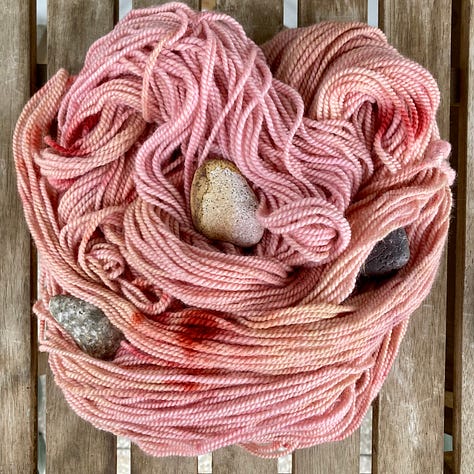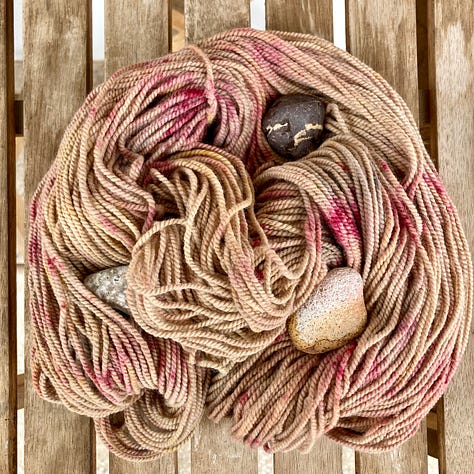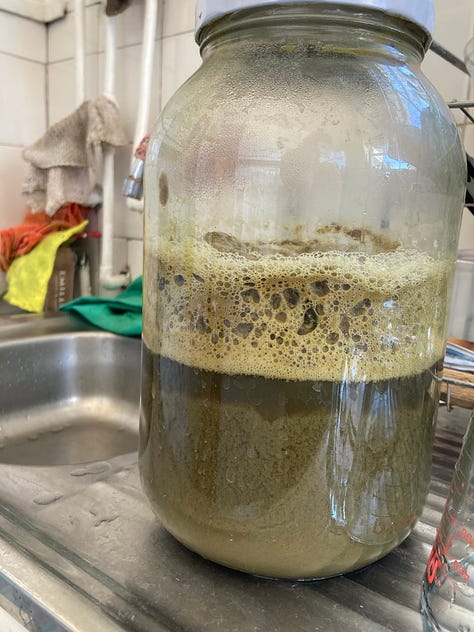Winter projects
This message is too long for email! You can read the complete post here.
This newsletter has English and Spanish versions. To choose which language you receive, visit your settings on Substack, find this newsletter under Subscriptions, and select the language(s) you want.
Leer en español aquí.
Winter has arrived in Viña del Mar, with shorter days, cold, foggy days, and, occasionally, rain. Nevertheless, this has been a production-focused month for me since I have upcoming projects and events with Neblina Wool. Through my natural dye practice I’ve learned about paying attention to seasons and cycles of nature, letting it dictate the work I do and the colors I produce at different times of year. But during May, it feels a little like I’m at cross-purposes with nature. Winter should be a slower time, a time for knitting and for rest. The shorter days make it difficult to get things done in the evening, when it’s cold and dark in my apartment, and the high humidity means that drying yarn takes two or three times as long. I do most of my dyeing and drying on my balcony, so when it rains, I have to prepare ahead of time, packing up my “studio” and making sure that no yarn is left out on the rack. I also tend to get a higher English teaching workload starting in April, which leaves me with less time to dedicate to hobbies or side hustles.


But on the other hand… it’s winter! People like to knit in winter! This generally means I have more opportunities to do shows and more people are interested in buying yarn. While it would be great to plan out my time in a way where I can dye extra yarn in the summer to prepare for this season, I’m not really able to do that right now. Even if I did have enough money to buy extra yarn in the summer, my two bedroom apartment already has too much yarn sitting around most of the time. So I tend to only place orders for yarn after I’ve sold a significant amount of what I already have. So that’s how I ended up with lots of yarn to dye in May, which I want to have ready for a show the first weekend in June. I love every minute I get to spend dyeing, but I’ve had to push myself a little to get everything done. A cold, damp month with short days and little sun isn’t really my ideal time to be working with lots of water. But I did manage to plan far enough ahead that I could set a schedule that’s not too demanding, that fits around my teaching obligations and accounts for the fact that I won’t really be able to get much done after the sun sets around 5:30.
Fortunately, my current projects are ones that really motivate me. For the first time, I was able to place an order for yarn from my friends at Bagual whose work I’ve long admired. Not only are they making beautiful, high quality wool, they are producing it entirely in Chile, from sheep to skein, with high environmental and social standards. Although there are plenty of sheep in Chile, producing fine wool here is a challenge because of the lack of processing equipment and mills and the difficulty farmers face in getting a good price for high quality fleeces. Bagual are working to change that and I’m thrilled to support them and give Chilean natural color to Chilean yarn.



I have two different bases. The first is their Merino worsted, which I’m using to dye a mini collection for winter (7 colors, dye lots of 3-4 skeins). I envision this yarn in a chunky sweater like this one that has been in my queue since it was released, so I’m saving some skeins for myself to make it, but it will be great for lots of winter sweaters or accessories. So far I’ve scoured and mordanted all of it and dyed the first five colors. One great thing about dyeing in May is that I’ve been able to collect rainwater for my cochineal dye bath, which should help me get some spectacular colors.
The second base is the Merino sport, which I’ve just begun to scour. This is the yarn that I’m bringing to Ohio for my July workshops and to dye with some local Ohio dye plants as well as the dye garden my parents have planted! I’m so excited to experience the colors of fresh indigo, weld, marigold, walnut, and more on this beautiful yarn, and I think the participants in my workshops will love it too!
An upcoming yarn show means I need more speckles. I have only a few left after Expo Teje so I need to make a few more batches. I’m low in stock on my usual Merino fingering base and haven’t been able to get more for the moment, so while I still have some fingering weight speckles I’m also experimenting with speckles on Merino DK. I’ve been overdyeing some solid colors that no longer excited me as solids. I think it works! Come see for yourself at Expo Lanera in Valparaíso next week.









I’ve also started making lake pigments from my leftover dye baths. Like indigo, it’s a process I avoided trying for a few years because I thought it seemed complicated, but it’s not, really. I keep it simple by making small quantities at a time. To make pigment, I measure the quantity of dye liquid I have and heat it gently in a pot (with plenty of room, since it will foam up when I add soda ash). I add about 10g of alum per liter of dye, and then the soda ash- about 5g per liter. This causes the dye liquid to foam up. I check the pH, which should be neutral- if it’s acidic, I add a little more soda ash, or if it’s too alkaline I add more alum. Then I pour the whole thing into a jar, because one of the most satisfying parts of this process is watching the pigment settle to the bottom, leaving a layer of water on top. I usually let it settle overnight, then the next day I pour off as much water as I can without losing too much sediment from the bottom. I pour off a little, let it settle again, pour a bit more, until there’s not too much water remaining. Finally, I arrange some coffee filters inside a strainer and pour the remaining contents of the jar through. Now I wait for all the extra liquid to drain through and for the pigment to dry. This takes several days, especially in my extremely humid winter climate.









Once it’s dry, I grind it as finely and evenly as I can using a mortar and pestle. This is the part I most enjoy, the sensation of the weird little chunks of dried pigment slowly becoming a fine, even powder. The visual and tactile satisfaction of this process is the main appeal of pigment making for me, since I haven’t actually figured out what to do with my little vials of pigment yet. You can use lake pigments to make art supplies such as paints, watercolors, crayons, oil pastels and more, but I’ve never really gotten into painting or drawing. So for now I haven’t done any further processing of my lake pigments, and just enjoy looking at them in their cute little jars. I’m trusting that when the moment is right, I’ll know what to do with them.
Upcoming events
June 3-4: Expo Lanera at Espacio Raíz in Valparaíso. I’m so excited to participate along with other amazing dyers from the V Region. I’m bringing new speckles and my winter collection on Bagual Worsted. Speckles are always one of a kind and the winter collection is in dye lots of three skeins each, so if you see something you want let me know and I can hold it! As I finish up the dyeing I’ll be sharing more photos on Instagram.
July 11 and 15: Natural dye workshops in Ohio. I’m teaching Naturally Dyed Speckles on July 11 and Indigo dyeing on July 15 at Behind the Pines in Pemberville, OH. Email neblina.wool@gmail.com for more info or to reserve a spot!




